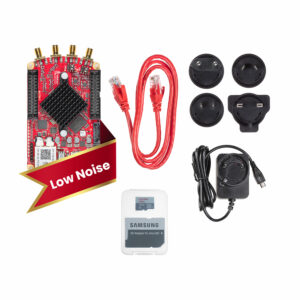Multi-channel solutions
Red Pitaya has put a special effort into enhancing its product portfolio with products which enable multi-channel signal acquisition and generation.
Both STEMlab 125-14 X-Channel System and STEMlab 125-14 4-Input are based on our best-selling STEMlab 125-14 board and are designed for applications which enable multi-channel approach.
Key features:
- Four inputs at 125 Msps 14-bit
- Internal/external clock selector available
- Performance improvements (less noise & crosstalk)
- AMD Xilinx Zynq 7020 SoC
Applications:
- Automotive Equipment
- Multi-channel Data Acquisition
- Base-Station IF Receivers
- Software Defined Radios
- Diversity Receivers
- Medical Imaging
- Communications
- Nondestructive Testing
- Test Equipment
- Cellular Base Stations
Technical specifications:
| Processor | Dual-Core ARM Cortex-A9 MPCore |
| FPGA | AMD Xilinx Zynq 7010 |
| RAM | 512MB (4Gb) |
| System memory | Micro SD up to 32GB |
Ethernet | 1 Gbit |
USB | USB 2.0 |
WI-FI | Using Wi-Fi dongle |
Channels | 4 |
Sample rate | 125MS/s |
ADC resolution | 14bit |
Full scale voltage range | +-1V / +-20V |
Input coupling | DC |
Bandwidth | DC-60MHz |
Input impedance | 1Mohm |
Digital IOs | 16 |
Analog inputs | 4 channels 0-3.5V 12bit |
Analog outputs | 4 channels 0-1.8V 12bit |
Communication interfaces | I2C, UART, SPI |
Available voltages | +5V, +3.3V, -4V |
Trigger input | through extension connector |
Daisy chain connection | over SATA connection |
Ref. clock input | through extension connector |
Key features:
- Designed for applications that require multi-channel RF signal acquisition and generation
- Consists of multiple STEMlab 125-14 devices
- Open-source multi-channel streaming software available (command line tool and Qt client app)
- Clock and trigger synchronization
- SCPI server support (Python, MATLAB, LabVIEW)
Applications:
- Power grid monitoring that requires multi-channel signal acquisition or generation solutions
- Readout of scientific multi-channel detectors
- Multi-channel SDR receivers
- Phased array antennas
- Nondestructive testing
- RADAR/LIDAR
- Medical and industrial imaging (MRI and ultrasound systems)
Technical specifications:
| Processor | Dual-Core ARM Cortex-A9 MPCore |
| FPGA | Xilinx Zynq 7010 |
| RAM | 512MB (4Gb) |
| System memory | Micro SD up to 32GB |
Ethernet | 1 Gbit |
USB | USB 2.0 |
WI-FI | Using Wi-Fi dongle |
Channels | 2 |
Sample rate | 125MS/s |
ADC resolution | 14bit |
Full scale voltage range | +-1V / +-20V |
Input coupling | DC |
Bandwidth | DC-60MHz |
Input impedance | 1Mohm |
Channels | 2 |
Sample rate | 125MS/s |
DAC resolution | 14 bit |
Full scale voltage range | +-1V |
Load impedance | 50 ohm |
Shortcut protection | Yes |
Typical rising/falling time | 2V / 10ns |
Bandwidth | DC – 50MHz |
Digital IOs | 16 |
Analog inputs | 4 channels 0-3.5V 12bit |
Analog outputs | 4 channels 0-1.8V 12bit |
Communication interfaces | I2C, UART, SPI |
Available voltages | +5V, +3.3V, -4V |
Trigger input | through extension connector |
Daisy chain connection | over SATA connection |
Ref. clock input | N/A |
Explore most popular multi-channel solutions

STEMlab 125-14 X-Channel System

STEMlab 125-14 4-Input
Explore more variations of the STEMlab 125-14 board





Our customers' testimonials
Red Pitayas in the classroom will offer university students an introduction to not only a wide variety of scientific and analytical instruments, but the electronics design, DSP (digital signal processing), FPGA and basic programming logic which is at the heart of many fields today.
Research Instruments Corporation incorporates a Red Pitaya into the core of its X-ray Plasma Sources. The Red Pitaya allows us to eliminate the need for a separate control computer and monitor the X-ray output in a reliable, compact and cost effective-manner. Thanks to their size, capability and reliability, Red Pitayas are the brain behind our X-ray sources going forward.
I have had the chance to have a Red Pitaya from the initial release. The device is my “go-to” desktop testing tool. Its capabilities far exceed its size. The best part is that the community is expanding as are the hardware and software options. The Red Pitaya is truly blossoming. I look forward to its future growth.
We are currently using Red Pitaya’s STEMlab 125-14 to check if communication signals are according to the specifications. We really value the versatility and portability of the board.